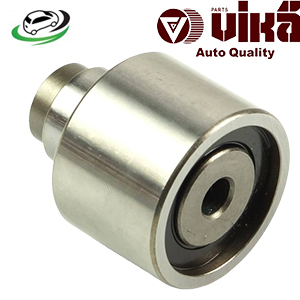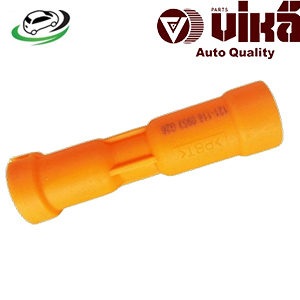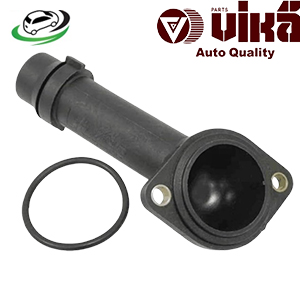-40%
Get Volkswagen Passat B5 FWD TDI Thermostat Housing 038121121B
The thermostat housing is a metal or plastic assembly that houses the thermostat within the engine’s cooling system. It is typically located near the engine block and serves as a junction for coolant flow, allowing the thermostat to regulate engine temperature by controlling the flow of coolant to the radiator.
Key Functions of the Thermostat Housing:
- Thermostat Support: Provides a secure mounting location for the thermostat.
- Coolant Regulation: Facilitates the flow of coolant through the engine and radiator based on temperature readings from the thermostat.
- Sealing Mechanism: Prevents coolant leaks from the cooling system.
2. Construction of the Thermostat Housing
The construction of the thermostat housing is designed for durability and efficiency. Key components include:
1. Housing Body:
- Material: Typically made from aluminum, plastic, or composite materials, which provide a balance of weight, strength, and resistance to corrosion.
- Shape: The housing is usually designed in a way that allows easy integration with the engine block and other cooling system components.
2. Thermostat Chamber:
- Design: The chamber is specifically designed to accommodate the thermostat, allowing for proper fit and function.
- Thermostat Installation: Includes mounting points or clips to secure the thermostat in place.
3. Inlet and Outlet Ports:
- Coolant Flow: These ports connect the thermostat housing to the engine block and radiator, allowing for the flow of coolant into and out of the housing.
- Gasket Seating: The surface of the ports often includes grooves or flat surfaces to accommodate gaskets, ensuring a tight seal and preventing leaks.
4. Gaskets and Seals:
- Material: Gaskets are typically made from rubber or silicone to provide a reliable seal against coolant leaks.
- Function: Prevents coolant from leaking between the thermostat housing and the engine block or other components.
3. Working Principle of the Thermostat Housing
The thermostat housing plays a critical role in the cooling system’s operation. Here’s how it works:
- Thermostat Functionality: The thermostat within the housing monitors the engine temperature. When the engine is cold, the thermostat remains closed, preventing coolant from circulating through the radiator.
- Temperature Regulation: As the engine warms up, the thermostat gradually opens at a predetermined temperature, allowing coolant to flow from the engine to the radiator.
- Coolant Flow Management: The thermostat housing directs coolant flow between the engine and radiator, helping to maintain optimal engine temperatures.
- Heat Dissipation: Once the coolant passes through the radiator, it cools down before returning to the engine. The thermostat housing continues to manage this cycle, ensuring efficient heat dissipation.
4. Applications of Thermostat Housing
Thermostat housings are used in a variety of applications, including:
1. Automotive Engines:
- Internal Combustion Engines: Found in nearly all gasoline and diesel engines, thermostat housings are critical for maintaining optimal operating temperatures.
2. Motorcycle Engines:
- Cooling Systems: Used in motorcycle engines to regulate temperature and ensure proper engine performance.
3. Industrial Equipment:
- Heavy Machinery: Employed in various industrial engines and equipment to manage coolant flow and temperature.
4. Marine Engines:
- Boat Applications: Used in marine engines where temperature regulation is essential for performance and reliability.
5. Advantages of Thermostat Housing
The thermostat housing offers several advantages, including:
1. Effective Temperature Regulation:
By providing a secure location for the thermostat, the housing ensures accurate temperature readings and efficient engine cooling.
2. Leak Prevention:
The use of gaskets and seals in the thermostat housing design minimizes the risk of coolant leaks, protecting the engine and cooling system.
3. Durability and Reliability:
Constructed from materials designed to withstand high temperatures and pressures, thermostat housings are built for long-lasting performance.
4. Ease of Maintenance:
The design of the thermostat housing allows for easy access to the thermostat for inspection or replacement, simplifying maintenance tasks.
5. Improved Engine Performance:
By maintaining optimal engine temperatures, the thermostat housing contributes to enhanced performance and fuel efficiency.
6. Maintenance of Thermostat Housing
Regular maintenance of the thermostat housing is essential for ensuring the proper operation of the engine’s cooling system. Here are some key maintenance tips:
1. Regular Inspections:
Periodically check the thermostat housing for signs of corrosion, cracks, or damage. Pay attention to coolant leaks around the housing and surrounding components.
2. Coolant Flushes:
Perform regular coolant flushes to remove contaminants and prevent buildup within the cooling system. This helps maintain the efficiency of the thermostat housing and the entire cooling system.
3. Gasket Replacement:
Replace gaskets and seals as needed, especially if you notice coolant leaks. Old or damaged gaskets can compromise the seal, leading to leaks and potential engine overheating.
4. Thermostat Testing:
Consider testing the thermostat periodically to ensure it opens and closes at the correct temperatures. A malfunctioning thermostat can lead to overheating or inadequate engine cooling.
5. Professional Inspections:
If you notice any issues with the engine temperature or suspect a problem with the thermostat housing, consult a professional mechanic for a thorough inspection.
7. Troubleshooting Common Issues
Identifying and addressing issues with the thermostat housing is crucial for preventing engine problems. Here are some common issues and their solutions:
1. Coolant Leaks:
- Symptoms: Visible coolant puddles under the vehicle or around the thermostat housing.
- Solution: Inspect the housing and gaskets for cracks or damage; replace any damaged components and ensure proper sealing.
2. Engine Overheating:
- Symptoms: The temperature gauge indicates high engine temperatures or warning lights illuminate.
- Solution: Check the thermostat for proper operation and inspect the thermostat housing for clogs or leaks. Replace the thermostat if necessary.
3. Low Coolant Levels:
- Symptoms: Coolant levels drop frequently, requiring constant topping off.
- Solution: Inspect the thermostat housing and surrounding areas for leaks. Address any leaks promptly.
4. Thermostat Malfunction:
- Symptoms: The engine runs too hot or too cold.
- Solution: Test or replace the thermostat if it is not opening or closing at the correct temperatures.
Conclusion
The thermostat housing is an essential component of an engine’s cooling system, playing a vital role in regulating temperature and ensuring optimal performance. Understanding its functions, construction, working principles, applications, advantages, maintenance, and troubleshooting tips is crucial for vehicle owners and technicians alike. Regular inspection and maintenance of the thermostat housing can prevent engine overheating, coolant leaks, and other related issues, ultimately extending the life of the engine and improving overall vehicle performance. By prioritizing the maintenance of this critical component, vehicle owners can enjoy reliable and efficient engine operation for years to come.
Follow us on Facebook for more parts.




Reviews
Clear filtersThere are no reviews yet.